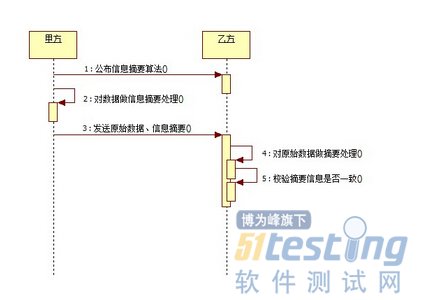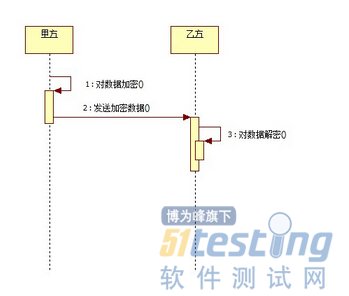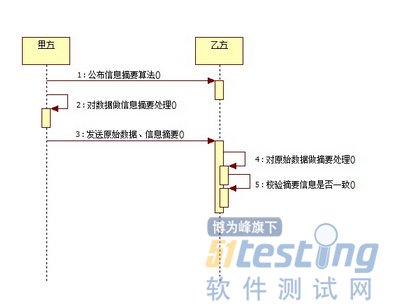Java加密算法研究
● BASE64 嚴格地說,屬于編碼格式,而非加密算法
● MD5(Message Digest algorithm 5,信息摘要算法)
● SHA(Secure Hash Algorithm,安全散列算法)
● HMAC(Hash Message Authentication Code,散列消息鑒別碼)復雜的對稱加密(DES、PBE)、非對稱加密算法:
● DES(Data Encryption Standard,數據加密算法)
● PBE(Password-based encryption,基于密碼驗證)
● RSA(算法的名字以發明者的名字命名:Ron Rivest, AdiShamir 和Leonard Adleman)
● DH(Diffie-Hellman算法,密鑰一致協議)
● DSA(Digital Signature Algorithm,數字簽名)
● ECC(Elliptic Curves Cryptography,橢圓曲線密碼編碼學)[/size]
-------------------------------------------------------------------------------------------------------------------------------------------
本篇內容簡要介紹BASE64、MD5、SHA、HMAC幾種加密算法。
BASE64編碼算法不算是真正的加密算法。
MD5、SHA、HMAC這三種加密算法,可謂是非可逆加密,就是不可解密的加密方法,我們稱之為單向加密算法。我們通常只把他們作為加密的基礎。單純的以上三種的加密并不可靠。
BASE64
按照RFC2045的定義,Base64被定義為:Base64內容傳送編碼被設計用來把任意序列的8位字節描述為一種不易被人直接識別的形式。(The Base64 Content-Transfer-Encoding is designed to represent arbitrary sequences of octets in a form that need not be humanly readable.)
常見于郵件、http加密,截取http信息,你就會發現登錄操作的用戶名、密碼字段通過BASE64加密的。
主要就是BASE64Encoder、BASE64Decoder兩個類,我們只需要知道使用對應的方法即可。另,BASE加密后產生的字節位數是8的倍數,如果不夠位數以=符號填充。
sun不推薦使用它們自己的base64,所以用apache的挺好!
MD5
MD5 -- message-digest algorithm 5 (信息-摘要算法)縮寫,廣泛用于加密和解密技術,常用于文件校驗。校驗?不管文件多大,經過MD5后都能生成唯一的MD5值。好比現在的ISO校驗,都是MD5校驗。怎么用?當然是把ISO經過MD5后產生MD5的值。一般下載linux-ISO的朋友都見過下載鏈接旁邊放著MD5的串。就是用來驗證文件是否一致的。
通常我們不直接使用上述MD5加密。通常將MD5產生的字節數組交給BASE64再加密一把,得到相應的字符串。
SHA
SHA(Secure Hash Algorithm,安全散列算法),數字簽名等密碼學應用中重要的工具,被廣泛地應用于電子商務等信息安全領域。雖然,SHA與MD5通過碰撞法都被破解了,但是SHA仍然是公認的安全加密算法,較之MD5更為安全。

可變MD5加密(Java實現)
可變在這里含義很簡單,就是最終的加密結果是可變的,而非必需按標準MD5加密實現。Java類庫security中的MessageDigest類就提供了MD5加密的支持,實現起來非常方便。為了實現更多效果,我們可以如下設計MD5工具類。
import java.security.MessageDigest; /** * 標準MD5加密方法,使用java類庫的security包的MessageDigest類處理 */ public class MD5 { /** * 獲得MD5加密密碼的方法 */ public static String getMD5ofStr(String origString) { String origMD5 = null; try { MessageDigest md5 = MessageDigest.getInstance("MD5"); // md5.update(origString.getBytes()); byte[] result = md5.digest(origString.getBytes()); origMD5 = byteArray2HexStr(result); // if ("123".equals(origString)) { // System.out.println(new String(result)); // System.out.println(new BigInteger(result).toString(16)); // } } catch (Exception e) { e.printStackTrace(); } return origMD5; } /** * 處理字節數組得到MD5密碼的方法 */ private static String byteArray2HexStr(byte[] bs) { StringBuffer sb = new StringBuffer(); for (byte b : bs) { sb.append(byte2HexStr(b)); } return sb.toString(); } /** * 字節標準移位轉十六進制方法 */ private static String byte2HexStr(byte b) { String hexStr = null; int n = b; if (n < 0) { // 若需要自定義加密,請修改這個移位算法即可 n = b & 0x7F + 128; } hexStr = Integer.toHexString(n / 16) + Integer.toHexString(n % 16); return hexStr.toUpperCase(); } /** * 提供一個MD5多次加密方法 */ public static String getMD5ofStr(String origString, int times) { String md5 = getMD5ofStr(origString); for (int i = 0; i < times - 1; i++) { md5 = getMD5ofStr(md5); } return getMD5ofStr(md5); } /** * 密碼驗證方法 */ public static boolean verifyPassword(String inputStr, String MD5Code) { return getMD5ofStr(inputStr).equals(MD5Code); } /** * 重載一個多次加密時的密碼驗證方法 */ public static boolean verifyPassword(String inputStr, String MD5Code, int times) { return getMD5ofStr(inputStr, times).equals(MD5Code); } /** * 提供一個測試的主函數 */ public static void main(String[] args) { System.out.println("123:" + getMD5ofStr("123")); System.out.println("123456789:" + getMD5ofStr("123456789")); System.out.println("sarin:" + getMD5ofStr("sarin")); System.out.println("123:" + getMD5ofStr("123", 4)); } } |
可以看出實現的過程非常簡單,因為由java類庫提供了處理支持。但是要清楚的是這種方式產生的密碼不是標準的MD5碼,它需要進行移位處理才能得到標準MD5碼。這個程序的關鍵之處也在這了,怎么可變?調整移位算法不就可變了么!不進行移位,也能夠得到32位的密碼,這就不是標準加密了,只要加密和驗證過程使用相同的算法就可以了。
MD5加密還是很安全的,像CMD5那些窮舉破解的只是針對標準MD5加密的結果進行的,如果自定義移位算法后,它還有效么?可以說是無解的了,所以MD5非常安全可靠。
為了更可變,還提供了多次加密的方法,可以在MD5基礎之上繼續MD5,就是對32位的第一次加密結果再MD5,恩,這樣去破解?沒有任何意義。
這樣在MIS系統中使用,安全可靠,歡迎交流,希望對使用者有用。
我們最后看看由MD5加密算法實現的類,那是非常龐大的。
import java.lang.reflect.*; /** * ********************************************** * md5 類實現了RSA Data Security, Inc.在提交給IETF * 的RFC1321中的MD5 message-digest 算法。 * *********************************************** */ public class MD5 { /* 下面這些S11-S44實際上是一個4*4的矩陣,在原始的C實現中是用#define 實現的, 這里把它們實現成為static final是表示了只讀,切能在同一個進程空間內的多個 Instance間共享*/ static final int S11 = 7; static final int S12 = 12; static final int S13 = 17; static final int S14 = 22; static final int S21 = 5; static final int S22 = 9; static final int S23 = 14; static final int S24 = 20; static final int S31 = 4; static final int S32 = 11; static final int S33 = 16; static final int S34 = 23; static final int S41 = 6; static final int S42 = 10; static final int S43 = 15; static final int S44 = 21; static final byte[] PADDING = { -128, 0, 0, 0, 0, 0, 0, 0, 0, 0, 0, 0, 0, 0, 0, 0, 0, 0, 0, 0, 0, 0, 0, 0, 0, 0, 0, 0, 0, 0, 0, 0, 0, 0, 0, 0, 0, 0, 0, 0, 0, 0, 0, 0, 0, 0, 0, 0, 0, 0, 0, 0, 0, 0, 0, 0, 0, 0, 0, 0, 0, 0, 0, 0 }; /* 下面的三個成員是MD5計算過程中用到的3個核心數據,在原始的C實現中 被定義到MD5_CTX結構中 */ private long[] state = new long[4]; // state (ABCD) private long[] count = new long[2]; // number of bits, modulo 2^64 (lsb first) private byte[] buffer = new byte[64]; // input buffer /* digestHexStr是MD5的唯一一個公共成員,是最新一次計算結果的 16進制ASCII表示. */ public String digestHexStr; /* digest,是最新一次計算結果的2進制內部表示,表示128bit的MD5值. */ private byte[] digest = new byte[16]; /* getMD5ofStr是類MD5最主要的公共方法,入口參數是你想要進行MD5變換的字符串 返回的是變換完的結果,這個結果是從公共成員digestHexStr取得的. */ public String getMD5ofStr(String inbuf) { md5Init(); md5Update(inbuf.getBytes(), inbuf.length()); md5Final(); digestHexStr = ""; for (int i = 0; i < 16; i++) { digestHexStr += byteHEX(digest[i]); } return digestHexStr; } // 這是MD5這個類的標準構造函數,JavaBean要求有一個public的并且沒有參數的構造函數 public MD5() { md5Init(); return; } /* md5Init是一個初始化函數,初始化核心變量,裝入標準的幻數 */ private void md5Init() { count[0] = 0L; count[1] = 0L; ///* Load magic initialization constants. state[0] = 0x67452301L; state[1] = 0xefcdab89L; state[2] = 0x98badcfeL; state[3] = 0x10325476L; return; } /* F, G, H ,I 是4個基本的MD5函數,在原始的MD5的C實現中,由于它們是 簡單的位運算,可能出于效率的考慮把它們實現成了宏,在java中,我們把它們 實現成了private方法,名字保持了原來C中的。 */ private long F(long x, long y, long z) { return (x & y) | ((~x) & z); } private long G(long x, long y, long z) { return (x & z) | (y & (~z)); } private long H(long x, long y, long z) { return x ^ y ^ z; } private long I(long x, long y, long z) { return y ^ (x | (~z)); } /* FF,GG,HH和II將調用F,G,H,I進行近一步變換 FF, GG, HH, and II transformations for rounds 1, 2, 3, and 4. Rotation is separate from addition to prevent recomputation. */ private long FF(long a, long b, long c, long d, long x, long s, long ac) { a += F(b, c, d) + x + ac; a = ((int) a << s) | ((int) a >>> (32 - s)); a += b; return a; } private long GG(long a, long b, long c, long d, long x, long s, long ac) { a += G(b, c, d) + x + ac; a = ((int) a << s) | ((int) a >>> (32 - s)); a += b; return a; } private long HH(long a, long b, long c, long d, long x, long s, long ac) { a += H(b, c, d) + x + ac; a = ((int) a << s) | ((int) a >>> (32 - s)); a += b; return a; } private long II(long a, long b, long c, long d, long x, long s, long ac) { a += I(b, c, d) + x + ac; a = ((int) a << s) | ((int) a >>> (32 - s)); a += b; return a; } /* md5Update是MD5的主計算過程,inbuf是要變換的字節串,inputlen是長度,這個 函數由getMD5ofStr調用,調用之前需要調用md5init,因此把它設計成private的 */ private void md5Update(byte[] inbuf, int inputLen) { int i, index, partLen; byte[] block = new byte[64]; index = (int) (count[0] >>> 3) & 0x3F; // /* Update number of bits */ if ((count[0] += (inputLen << 3)) < (inputLen << 3)) count[1]++; count[1] += (inputLen >>> 29); partLen = 64 - index; // Transform as many times as possible. if (inputLen >= partLen) { md5Memcpy(buffer, inbuf, index, 0, partLen); md5Transform(buffer); for (i = partLen; i + 63 < inputLen; i += 64) { md5Memcpy(block, inbuf, 0, i, 64); md5Transform(block); } index = 0; } else i = 0; ///* Buffer remaining input */ md5Memcpy(buffer, inbuf, index, i, inputLen - i); } /* md5Final整理和填寫輸出結果 */ private void md5Final() { byte[] bits = new byte[8]; int index, padLen; ///* Save number of bits */ Encode(bits, count, 8); ///* Pad out to 56 mod 64. index = (int) (count[0] >>> 3) & 0x3f; padLen = (index < 56) ? (56 - index) : (120 - index); md5Update(PADDING, padLen); ///* Append length (before padding) */ md5Update(bits, 8); ///* Store state in digest */ Encode(digest, state, 16); } /* md5Memcpy是一個內部使用的byte數組的塊拷貝函數,從input的inpos開始把len長度的 字節拷貝到output的outpos位置開始 */ private void md5Memcpy(byte[] output, byte[] input, int outpos, int inpos, int len) { int i; for (i = 0; i < len; i++) output[outpos + i] = input[inpos + i]; } /* md5Transform是MD5核心變換程序,有md5Update調用,block是分塊的原始字節 */ private void md5Transform(byte block[]) { long a = state[0], b = state[1], c = state[2], d = state[3]; long[] x = new long[16]; Decode(x, block, 64); /* Round 1 */ a = FF(a, b, c, d, x[0], S11, 0xd76aa478L); /* 1 */ d = FF(d, a, b, c, x[1], S12, 0xe8c7b756L); /* 2 */ c = FF(c, d, a, b, x[2], S13, 0x242070dbL); /* 3 */ b = FF(b, c, d, a, x[3], S14, 0xc1bdceeeL); /* 4 */ a = FF(a, b, c, d, x[4], S11, 0xf57c0fafL); /* 5 */ d = FF(d, a, b, c, x[5], S12, 0x4787c62aL); /* 6 */ c = FF(c, d, a, b, x[6], S13, 0xa8304613L); /* 7 */ b = FF(b, c, d, a, x[7], S14, 0xfd469501L); /* 8 */ a = FF(a, b, c, d, x[8], S11, 0x698098d8L); /* 9 */ d = FF(d, a, b, c, x[9], S12, 0x8b44f7afL); /* 10 */ c = FF(c, d, a, b, x[10], S13, 0xffff5bb1L); /* 11 */ b = FF(b, c, d, a, x[11], S14, 0x895cd7beL); /* 12 */ a = FF(a, b, c, d, x[12], S11, 0x6b901122L); /* 13 */ d = FF(d, a, b, c, x[13], S12, 0xfd987193L); /* 14 */ c = FF(c, d, a, b, x[14], S13, 0xa679438eL); /* 15 */ b = FF(b, c, d, a, x[15], S14, 0x49b40821L); /* 16 */ /* Round 2 */ a = GG(a, b, c, d, x[1], S21, 0xf61e2562L); /* 17 */ d = GG(d, a, b, c, x[6], S22, 0xc040b340L); /* 18 */ c = GG(c, d, a, b, x[11], S23, 0x265e5a51L); /* 19 */ b = GG(b, c, d, a, x[0], S24, 0xe9b6c7aaL); /* 20 */ a = GG(a, b, c, d, x[5], S21, 0xd62f105dL); /* 21 */ d = GG(d, a, b, c, x[10], S22, 0x2441453L); /* 22 */ c = GG(c, d, a, b, x[15], S23, 0xd8a1e681L); /* 23 */ b = GG(b, c, d, a, x[4], S24, 0xe7d3fbc8L); /* 24 */ a = GG(a, b, c, d, x[9], S21, 0x21e1cde6L); /* 25 */ d = GG(d, a, b, c, x[14], S22, 0xc33707d6L); /* 26 */ c = GG(c, d, a, b, x[3], S23, 0xf4d50d87L); /* 27 */ b = GG(b, c, d, a, x[8], S24, 0x455a14edL); /* 28 */ a = GG(a, b, c, d, x[13], S21, 0xa9e3e905L); /* 29 */ d = GG(d, a, b, c, x[2], S22, 0xfcefa3f8L); /* 30 */ c = GG(c, d, a, b, x[7], S23, 0x676f02d9L); /* 31 */ b = GG(b, c, d, a, x[12], S24, 0x8d2a4c8aL); /* 32 */ /* Round 3 */ a = HH(a, b, c, d, x[5], S31, 0xfffa3942L); /* 33 */ d = HH(d, a, b, c, x[8], S32, 0x8771f681L); /* 34 */ c = HH(c, d, a, b, x[11], S33, 0x6d9d6122L); /* 35 */ b = HH(b, c, d, a, x[14], S34, 0xfde5380cL); /* 36 */ a = HH(a, b, c, d, x[1], S31, 0xa4beea44L); /* 37 */ d = HH(d, a, b, c, x[4], S32, 0x4bdecfa9L); /* 38 */ c = HH(c, d, a, b, x[7], S33, 0xf6bb4b60L); /* 39 */ b = HH(b, c, d, a, x[10], S34, 0xbebfbc70L); /* 40 */ a = HH(a, b, c, d, x[13], S31, 0x289b7ec6L); /* 41 */ d = HH(d, a, b, c, x[0], S32, 0xeaa127faL); /* 42 */ c = HH(c, d, a, b, x[3], S33, 0xd4ef3085L); /* 43 */ b = HH(b, c, d, a, x[6], S34, 0x4881d05L); /* 44 */ a = HH(a, b, c, d, x[9], S31, 0xd9d4d039L); /* 45 */ d = HH(d, a, b, c, x[12], S32, 0xe6db99e5L); /* 46 */ c = HH(c, d, a, b, x[15], S33, 0x1fa27cf8L); /* 47 */ b = HH(b, c, d, a, x[2], S34, 0xc4ac5665L); /* 48 */ /* Round 4 */ a = II(a, b, c, d, x[0], S41, 0xf4292244L); /* 49 */ d = II(d, a, b, c, x[7], S42, 0x432aff97L); /* 50 */ c = II(c, d, a, b, x[14], S43, 0xab9423a7L); /* 51 */ b = II(b, c, d, a, x[5], S44, 0xfc93a039L); /* 52 */ a = II(a, b, c, d, x[12], S41, 0x655b59c3L); /* 53 */ d = II(d, a, b, c, x[3], S42, 0x8f0ccc92L); /* 54 */ c = II(c, d, a, b, x[10], S43, 0xffeff47dL); /* 55 */ b = II(b, c, d, a, x[1], S44, 0x85845dd1L); /* 56 */ a = II(a, b, c, d, x[8], S41, 0x6fa87e4fL); /* 57 */ d = II(d, a, b, c, x[15], S42, 0xfe2ce6e0L); /* 58 */ c = II(c, d, a, b, x[6], S43, 0xa3014314L); /* 59 */ b = II(b, c, d, a, x[13], S44, 0x4e0811a1L); /* 60 */ a = II(a, b, c, d, x[4], S41, 0xf7537e82L); /* 61 */ d = II(d, a, b, c, x[11], S42, 0xbd3af235L); /* 62 */ c = II(c, d, a, b, x[2], S43, 0x2ad7d2bbL); /* 63 */ b = II(b, c, d, a, x[9], S44, 0xeb86d391L); /* 64 */ state[0] += a; state[1] += b; state[2] += c; state[3] += d; } /*Encode把long數組按順序拆成byte數組,因為java的long類型是64bit的, 只拆低32bit,以適應原始C實現的用途 */ private void Encode(byte[] output, long[] input, int len) { int i, j; for (i = 0, j = 0; j < len; i++, j += 4) { output[j] = (byte) (input[i] & 0xffL); output[j + 1] = (byte) ((input[i] >>> 8) & 0xffL); output[j + 2] = (byte) ((input[i] >>> 16) & 0xffL); output[j + 3] = (byte) ((input[i] >>> 24) & 0xffL); } } /*Decode把byte數組按順序合成成long數組,因為java的long類型是64bit的, 只合成低32bit,高32bit清零,以適應原始C實現的用途 */ private void Decode(long[] output, byte[] input, int len) { int i, j; for (i = 0, j = 0; j < len; i++, j += 4) output[i] = b2iu(input[j]) | (b2iu(input[j + 1]) << 8) | (b2iu(input[j + 2]) << 16) | (b2iu(input[j + 3]) << 24); return; } /* b2iu是我寫的一個把byte按照不考慮正負號的原則的"升位"程序,因為java沒有unsigned運算 */ public static long b2iu(byte b) { return b < 0 ? b & 0x7F + 128 : b; } /*byteHEX(),用來把一個byte類型的數轉換成十六進制的ASCII表示, 因為java中的byte的toString無法實現這一點,我們又沒有C語言中的 sprintf(outbuf,"%02X",ib) */ public static String byteHEX(byte ib) { char[] Digit = { '0', '1', '2', '3', '4', '5', '6', '7', '8', '9', 'A', 'B', 'C', 'D', 'E', 'F' }; char[] ob = new char[2]; ob[0] = Digit[(ib >>> 4) & 0X0F]; ob[1] = Digit[ib & 0X0F]; String s = new String(ob); return s; } public static void main(String args[]) { MD5 m = new MD5(); if (Array.getLength(args) == 0) { //如果沒有參數,執行標準的Test Suite System.out.println("MD5 Test suite:"); System.out.println("MD5(\"\"):" + m.getMD5ofStr("")); System.out.println("MD5(\"a\"):" + m.getMD5ofStr("a")); System.out.println("MD5(\"abc\"):" + m.getMD5ofStr("abc")); System.out.println("MD5(\"11\"):" + m.getMD5ofStr("11")); System.out.println("MD5(\"123\"):" + m.getMD5ofStr("123")); System.out.println("MD5(\"message digest\"):" + m.getMD5ofStr("message digest")); System.out.println("MD5(\"abcdefghijklmnopqrstuvwxyz\"):" + m.getMD5ofStr("abcdefghijklmnopqrstuvwxyz")); System.out.println("MD5(\"ABCDEFGHIJKLMNOPQRSTUVWXYZabcdefghijklmnopqrstuvwxyz0123456789\"):" + m.getMD5ofStr("ABCDEFGHIJKLMNOPQRSTUVWXYZabcdefghijklmnopqrstuvwxyz0123456789")); } else System.out.println("MD5(" + args[0] + ")=" + m.getMD5ofStr(args[0])); } } |
posted on 2014-07-21 09:53 順其自然EVO 閱讀(257) 評論(0) 編輯 收藏 所屬分類: 測試學習專欄





